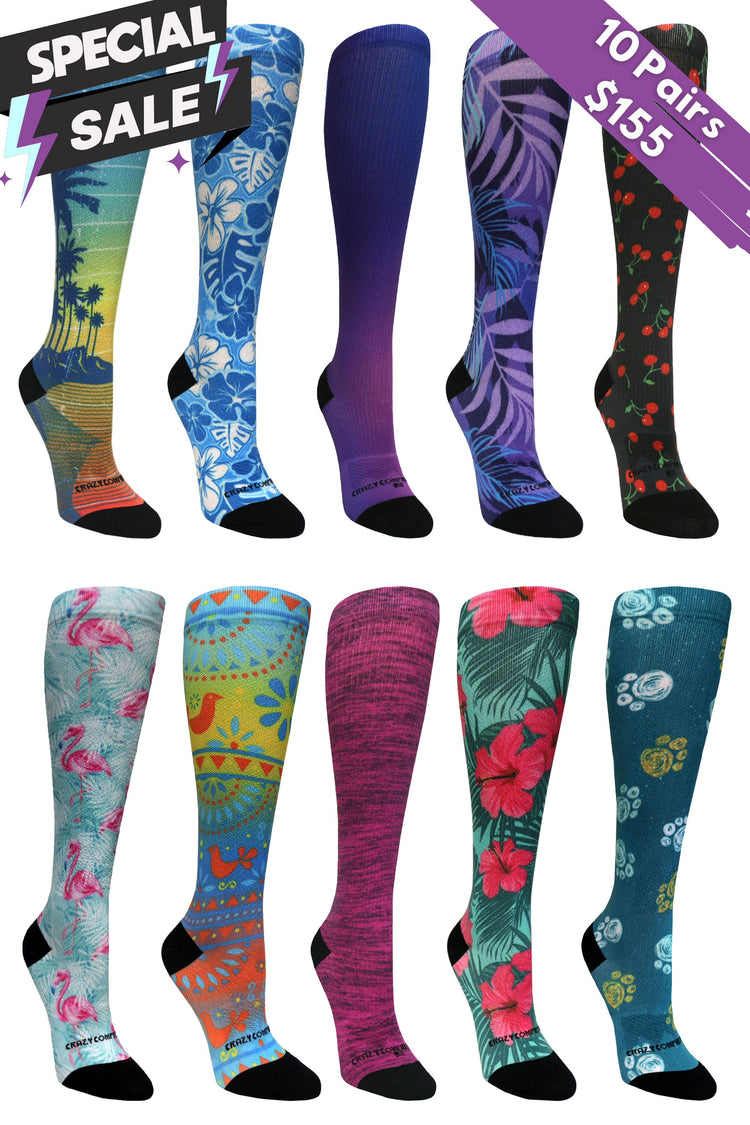If you’ve ever stepped out of bed in the morning only to be met with a stabbing pain in your heel then you understand the discomfort of plantar fasciitis. As one of the most common causes of heel and foot pain, plantar fasciitis is an inflammatory condition that can affect people of any age and stems from a variety of issues.
But what exactly is plantar fasciitis, what causes it, and can socks really help keep you on your feet? We’ve taken a look at the plantar fasciitis sock options to help you get back moving comfortably.
What Is Plantar Fasciitis?
Running along the underside of your foot is the plantar fascia, a fibrous piece of connective tissue linking the ball of the heel to the toes. Think of it like a thick rubber band that connects the bones in your foot and creates the arch.
The plantar fascia is involved in normal foot movement and physical activity, but inflammation can occur when it is overused or overstretched. This is known as plantar fasciitis, a condition that affects around 1 in 10 people at some point in their life. 83% of sufferers lead active lifestyles, and most people are 40-60 when they start to experience symptoms.
What Does Plantar Fasciitis Feel Like?
Plantar fasciitis can be described as a sharp, stabbing pain in the rear of the foot near the heel. It’s usually most noticeable first thing in the morning and may ease as you start to move around, but can also happen after long periods of standing. In some cases, you may only experience symptoms after you get up from sitting.
You may also notice swelling, stiffness, pain in the arch of your foot, or tightness in the Achilles. Most people experience plantar fasciitis in one foot at a time, but it’s also possible to have it in both feet.
What Causes Plantar Fasciitis?
Plantar fasciitis can develop without an obvious cause, but anything that irritates the plantar fascia may increase your likelihood of developing this uncomfortable condition. These include:
- Certain types of exercise: Activities that place a lot of pressure on the tissue in your feet, such as long-distance running or ballet, can cause plantar fasciitis. Not warming up and stretching can also contribute to inflammation.
- Spending hours on your feet: Jobs that require long shifts of standing, like nurses or factory workers, can increase your risk of developing plantar fasciitis.
- Age: Plantar fasciitis is more common in those aged 40-60.
- Obesity: Higher body mass can put more stress on the tissues in your feet.
- Foot mechanics: Flat feet or high arches can increase your likelihood of plantar fasciitis.
- Wearing unsupportive footwear: Shoes such as flip-flops or flat sneakers can cause excess strain on your plantar fascia.
How to Manage Plantar Fasciitis
While there’s unfortunately no quick fix to plantar fasciitis, there are some simple lifestyle modifications that can help you manage the discomfort and prevent future flare-ups. If you suspect that you may have plantar fasciitis or have been recently diagnosed, then consider:
Rest
As plantar fasciitis is an inflammation of the connective tissue in your feet, the first thing is to limit the stress. Take a break from any sports or unnecessary long stretches of standing for about a week or so, if possible.
Ice
Using a frozen water bottle or ice pack covered in a thin cloth, ice your foot for 10-15 minutes twice a day. This will help to reduce any swelling and pain.
NSAIDs
Non-steroidal anti-inflammatories such as ibuprofen, naproxen, or aspirin, can help to reduce the inflammation and pain caused by plantar fasciitis. However, over-the-counter medication is not a long-term solution, so talk to your doctor if you don’t find relief within a few days.
Wearing Supportive Shoes or Inserts
Plantar fasciitis can be caused by being barefoot or wearing unsupportive shoes, so switching to more sturdy, cushioned shoes may help you find relief. Orthotic inserts may also provide support to the arches of your feet.
Consider Plantar Fasciitis Socks
Another way to provide consistent support to your arches is with plantar fasciitis socks. Anecdotal evidence strongly suggests that compression can help manage the pain and swelling caused by plantar fasciitis, especially when combined with other management techniques. Compression garments also encourage overall lower leg health, boost circulation, and help keep your feet in tip-top condition.
Some compression socks, known as graduated compression socks, provide consistent, firm compression to the feet, arches, ankles, and lower legs. These supportive garments can help to boost circulation and are useful for a range of other conditions, too, such as arthritis, poor circulation, or diabetes. Athletes can also benefit from compression socks for recovery and overall lower limb health, and these garments provide additional support for plantar fasciitis from overexertion.
Specific plantar fasciitis socks, sometimes known as sleeves, are also available, and these apply compression specifically to the arches of the feet. There are even night braces available that keep your feet stretched out overnight!
Crazy Compression Socks for Plantar Fasciitis
Finding the right treatment plan and pair of plantar fasciitis socks for you is a personal journey, but rest assured that relief is available. Crazy Compression’s range of high-quality graduated compression socks provide firm, consistent pressure to your tender feet, and may help you manage the pain and swelling of plantar fasciitis.
Crazy Compression’s range of knee-high compression socks and active socks are specifically engineered to provide support and light cushioning to your feet. While plantar fasciitis can be uncomfortable and frustrating, Crazy Compression can help you find some relief and reclaim that spring in your step.

































Leave a comment
This site is protected by hCaptcha and the hCaptcha Privacy Policy and Terms of Service apply.